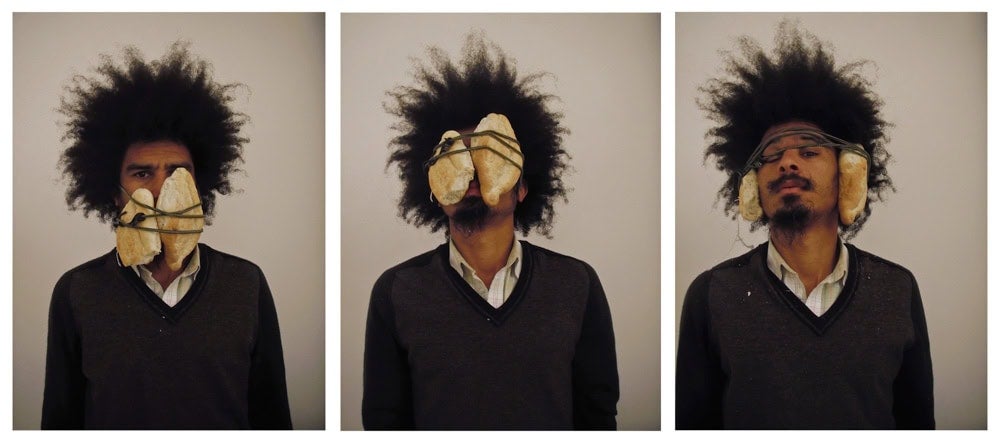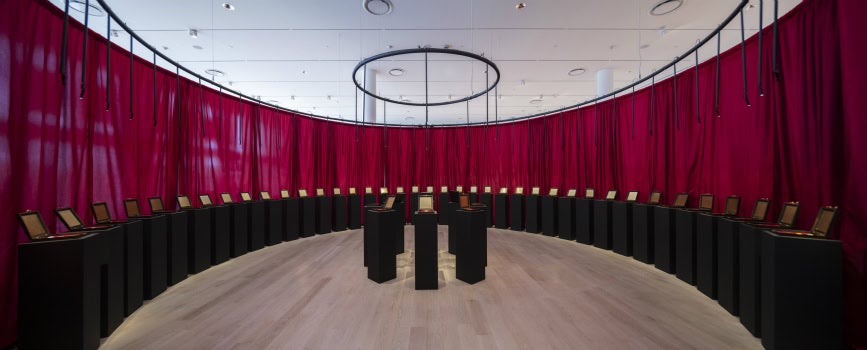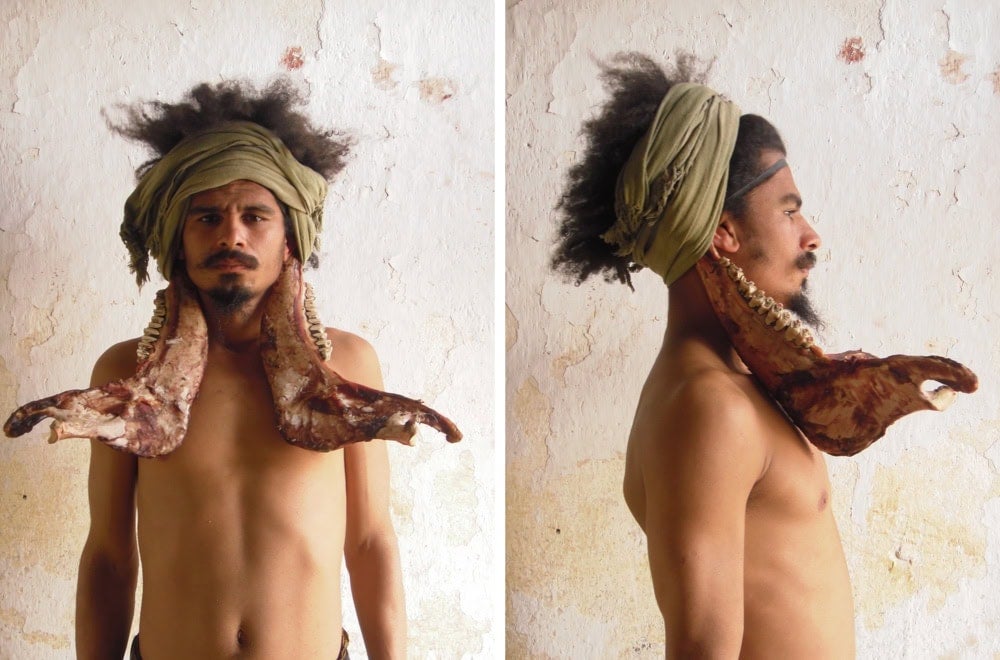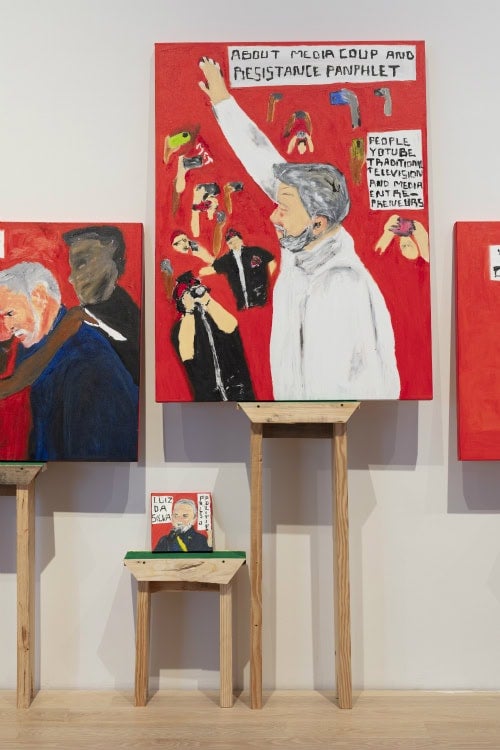
The force that drives the work of the protean Brazilian artist Paulo Nazareth derives in part from his life: a preoccupation with the complexities of his African and Indigenous heritage. Melee, a solo exhibition of works by Nazareth at ICA Miami, offers a potent crônica of his incisive work in a variety of media to date. It’s fitting that the show, his first in the United States, should be staged in Miami: it was here, eight years earlier at Art Basel Miami Beach, that Nazareth first attracted attention as he hawked hands of bananas that spilled from a rusty, emerald Volkswagen minibus as part of his performance-installation Banana Market/Art Market.
In Melee, Nazareth cuts a decidedly austere figure. With excavation—of history, memory—as his primary method, he focuses on the histories of individuals whose fates have been eclipsed by the outsize twin shadows of political oppression and systemic racism cast across his native Brazil and, more broadly, Latin America.
Part of Nazareth’s project is to counter the pernicious amnesia that muddles histories of Latin America—a thick fog that enshrouds the concussed political landscapes that dot the region. In Brazil, authorities have repeatedly attempted to furnish a narrative of the country conveniently shorn of the malevolence that has undercut it for decades. Accounts of the military dictatorship (1964-1985)—its tortures, disappearances, murders, the racial violence, and countless other human rights abuses—are grossly amended in a bid to shape a collective memory evacuated of the cruelty and corruption that has long blighted this history.

Nazareth disabuses viewers of any such notion of an unbruised past. His preoccupation with the effaced is at the heart of the monumental installation 49 Medals (2019), the centerpiece of the show. Ensconced within a long, red curtain and solemnly lit, the installation memorializes those for whom resistance was a common cause. A central mass of black pedestals topped with wooden cases displaying bronze medals is skirted by a row of the same. The medals, numbering forty-nine in total, are engraved with the names and likenesses of men and women, mostly Black and Indigenous, who were critical to the revolutionary history of the Americas from the fifteenth to the twentieth centuries. But the presences illumined in the glinting surfaces are of those seldom deemed worthy of commemoration: Toussaint L’Ouverture, Huey Newton, the transgender colonel of the Mexican Revolution Amelio Robles Ávila, Carlos Marighella, Nanny of the Maroons, among others. Here are the figures who suffer the threat of being swallowed by dusty obscurity, discredited in the historical record, slighted or altogether expunged by the powers that be.
Like his contemporaries Rosana Paulino and Jaime Lauriano, Nazareth belongs to a cadre of Afro-Brazilian artists who treat Brazilian history as an object of sustained and rigorous scrutiny. Their work revisits violent episodes in their country’s past, grapples with archives and the aftereffects of colonialism, and interrogates the marginal social status of exploited people.
The subject of thwarted autonomy looms over the show. For Utopia Signs (2019), vertically draped flags line the top of the gallery windows. The flags represent failed states, nations that have crumbled into dissolution and others that are presently beleaguered. We see the tricolor pattern of Palestine, the golden hammer and sickle of the Soviet Union, the bright green, red, and yellow of the Kanaka Maoli flag, the long-ago Hawaiian flag before the British discarded it in the late nineteenth century. Together, they assume a ceremonious air, as though displayed in a formal government hall. They remind of what could have been, of nations that might have thrived were it not for conditions that militate against their will, their survival.
Just beneath the flags rests a huddle of dense resin blocks with a purplish, wretched glow that comprise CA – Products of Genocide (2019). Encased fossil-like within each is a commodity whose packaging appropriates a name of indigenous origin or the figure of an indigenous person. The figures plastered on these products are marketed with a genial cast, but immured within the resin they become totems of the dispossessed, projecting a dire history that persists within the Americas.

This grim tone pervades a pair of videos entitled Antropologia do Negro I and II (2014). Set in a plywood tabletop, the videos show Nazareth lying supine as he piles dozens of skulls onto his head. Lost amid the clutter of bones, a faint sign of life appears in the form of the measured rippling of breath through Nazareth’s chest as his torso expands against the waistband of his pants. The skulls (remains of patients institutionalized at a sordid psychiatric hospital in the city of Barbacena) allude to the grisly death that has stalked Brazil’s past. They are the kind of thing that one might find digging anywhere in Latin America, where the “possibility of coming across bones by chance” is ever-present. “I dig,” Nazareth once said, “like a dog,” in search not only of physical remains but of the ghostly “fragments of memory” that linger, too. These traces, tangible or otherwise, are culled from lots not unlike the one featured in Buracos En La Ribera (2009). In this video, Nazareth heaves mounds of dirt by hand from the ground at La Ribera, one of the brutal detention centers used during Argentina’s Dirty War. By the end, he slips into the earth.

Inevitably, this acute examination of the past turns Nazareth’s face toward the present. A timely group of paintings propped alongside one another on wooden stands rests humbly against the rightmost gallery wall. The works center on the widely popular former Brazilian president Luis Inácio Lula da Silva, or Lula, who was imprisoned, in 2017, as part of the Lava Jato operations led by federal judge Sérgio Moro under the guise of justice, in an effort to thrust himself and his coconspirators into the administration. Lula has become something of a martyr since his imprisonment (“Lula Livre” is the fervent call); Jair Bolsonaro has since assumed the presidency, dragging in odious policies and everywhere stoking malicious sentiments. In one work, Lula poses alongside the late South African politician Nelson Mandela and the Mozambican revolutionary Eduardo Mondlane. Ordained under the aegis of a stout, black star, the men stand as saints of global political injustice.
But the urgency of Nazareth’s work is at times hampered by the curatorial logic that underpins the show. Manual Do Guerrilheiro Urbano (2019) presents newly printed copies of a seditious, bristling document of resistance literature composed by the Brazilian guerilla fighter Carlos Marighella in 1969, as the country writhed under the military regime. The curators are a bit heavy-handed in its presentation. Its object label curiously, if unduly, informs: “Nazareth has reproduced the document as it was originally written, without any alterations, thus turning the widely available text into sculpture.” Sculpture—of all things. Ultimately, one wonders if the exhibition subdues too much of the roving, restless aspect of Nazareth’s character, as few of the works shown here are drawn from the extensive travels that are so much a part of his practice.
Paulo Nazareth: Melee is on view at ICA Miami through October 6.




